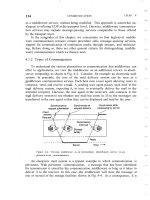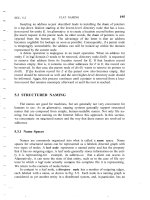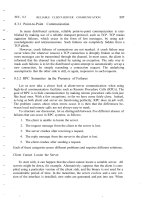DISTRIBUTED SYSTEMS principles and paradigms Second Edition phần 1 pot
Bạn đang xem bản rút gọn của tài liệu. Xem và tải ngay bản đầy đủ của tài liệu tại đây (3.28 MB, 71 trang )
DISTRIBUTED SYSTEMS
Second Edition
About the Authors
Andrew S. Tanenbaum has an S.B. degree from M.LT. and a Ph.D. from the University
of California at Berkeley. He is currently a Professor of Computer Science at the Vrije
Universiteit in Amsterdam, The Netherlands, where he heads the Computer Systems
Group. Until stepping down in Jan. 2005, for 12 years he had been Dean of the Advanced
School for Computing and Imaging, an interuniversity graduate school doing research on
advanced parallel, distributed, and imaging systems.
In the past. he has done research on compilers, operating systems, networking, and
local-area distributed systems. His current research focuses primarily on computer secu-
rity, especially in operating systems, networks, and large wide-area distributed systems.
Together, all these research projects have led to over 125 refereed papers in journals and
conference proceedings and five books, which have been translated into 21 languages.
Prof. Tanenbaum has also produced a considerable volume of software. He was the
principal architect of the Amsterdam Compiler Kit, a toolkit for writing portable com-
pilers, as well as of MINIX, a small UNIX clone aimed at very high reliability. It is avail-
able for free at www.minix3.org.This system provided the inspiration and base on which
Linux was developed. He was also one of the chief designers of Amoeba and Globe.
His Ph.D. students have gone on to greater glory after getting their degrees. He is
very proud of them. In this respect he resembles a mother hen.
Prof. Tanenbaum is a Fellow of the ACM, a Fellow of the the IEEE, and a member of
the Royal Netherlands Academy of Arts and Sciences. He is also winner of the 1994
ACM Karl V. Karlstrom Outstanding Educator Award, winner of the 1997
ACM/SIGCSE
Award for Outstanding Contributions to Computer Science Education, and winner of the
2002 Texty award for excellence in textbooks. In 2004 he was named as one of the five
new Academy Professors by the Royal Academy. His home page is at www.cs.vu.nl/r-ast.
Maarten van Steen is a professor at the Vrije Universiteit, Amsterdam, where he teaches
operating systems, computer networks, and distributed systems. He has also given various
highly successful courses on computer systems related subjects to ICT professionals from
industry and governmental organizations.
Prof. van Steen studied Applied Mathematics at Twente University and received a
Ph.D. from Leiden University in Computer Science. After his graduate studies he went to
work for an industrial research laboratory where he eventually became head of the Com-
puter Systems Group, concentrating on programming support for parallel applications.
After five years of struggling simultaneously do research and management, he decided
to return to academia, first as an assistant professor in Computer Science at the Erasmus
University Rotterdam, and later as an assistant professor in Andrew Tanenbaum's group at
the Vrije Universiteit Amsterdam. Going back to university was the right decision; his
wife thinks so, too.
His current research concentrates on large-scale distributed systems. Part of his
research focuses on Web-based systems, in particular adaptive distribution and replication
in Globule, a content delivery network of which his colleague Guillaume Pierre is the chief
designer. Another subject of extensive research is fully decentralized (gossip-based) peer-
to-peer systems of which results have been included in Tribler, a BitTorrent application
developed in collaboration with colleagues from the Technical University of Delft.
DISTRIBUTED SYSTEMS
Second Edition '
Andrew S.Tanenbaum
Maarten Van Steen
Upper Saddle River, NJ 07458
Library of Congress Ca.aloging-in.Public:ation Data
Tanenbaum. Andrew S.
Distributed systems: principles and paradigms
I
Andrew S. Tanenbaum, Maarten Van Steen.
p. em.
Includes bibliographical references and index.
ISBN 0-13-239227-5
1. Electronic data processing Distributed processing. 2. Distributed operating systems (Computers) I. Steen,
Maarten van. II. Title.
QA 76.9.D5T36 2006
005.4'476 dc22
2006024063
Vice President and Editorial Director. ECS: Marcia J. Horton
Executive Editor: Tracy Dunkelberger
Editorial Assistant: Christianna Lee
Associtate Editor: Carole Stivder
Executive Managing Editor: 'Vince O'Brien
Managing Editor: Csmille Tremecoste
Production Editor: Craig Little
Director of Creative Services: Paul Belfanti
Creative Director: Juan Lopez
Art Director: Heather Scott
Cover Designer: Tamara Newnam
Art Editor: Xiaohong Zhu
Manufacturing Manager, ESM: Alexis Heydt-Long
Manufacturing Buyer: Lisa McDowell
Executive Marketing Manager: Robin O'Brien
Marketing Assistant: Mack Patterson
© 2007 Pearson Education. Inc.
Pearson Prentice Hall
Pearson Education, Inc.
Upper Saddle River, NJ 07458
All rights reserved. No part of this book may be reproduced in any form or by any means, without permission in
writing from the publisher.
Pearson Prentice Hall~ is a trademark of Pearson Education, Inc.
The author and publisher of this book have used their best efforts in preparing this book. These efforts include the
development, research, and testing of the theories and programs to determine their effectiveness. The author and
publisher make no warranty of any kind, expressed or implied, with regard to these programs or the documentation
contained in this book. The author and publisher shall not be liable in any event for incidental or consequential
damages in connection with, or arising out of, the furnishing, performance, or use of these programs.
Printed in the United States of America
10 9 8 7 6 5 4 3 2 1
ISBN: 0-13-239227-5
Pearson Education Ltd., London
Pearson Education Australia Pty. Ltd.,
Sydney
Pearson Education Singapore, Pte. Ltd.
Pearson Education North Asia Ltd., Hong Kong
Pearson Education Canada, Inc., Toronto
Pearson Educaci6n de Mexico, S.A. de C.V.
Pearson Education-Japan, Tokyo
Pearson Education Malaysia, Pte. Ltd.
Pearson Education, Inc., Upper Saddle River,
New
Jersey
To Suzanne, Barbara, Marvin, and the memory of Bram and Sweetie 1t
-AST
To
Marielle,
Max, and Elke
-MvS
PREFACE
xvii
1
INTRODUCTION
1
1.1 DEFINITION OF A DISTRIBUTED SYSTEM 2
1.2 GOALS 3
1.2.1 Making Resources Accessible 3
1.2.2 Distribution Transparency 4
1.2.3 Openness 7
1.2.4 Scalability 9
1.2.5 Pitfalls 16
1.3 TYPES OF DISTRIBUTED SYSTEMS 17
1.3.1 Distributed Computing Systems 17
1.3.2 Distributed Information Systems 20
1.3.3 Distributed Pervasive Systems 24
1.4 SUMMARY 30
2
ARCHITECTURES 33
2.1 ARCHITECTURAL STYLES 34
2.2 SYSTEM ARCHITECTURES 36
2.2.1 Centralized Architectures 36
2.2.2 Decentralized Architectures 43
2.2.3 Hybrid Architectures 52
2.3 ARCHITECTURES VERSUS MIDDLEWARE 54
2.3.1 Interceptors 55
2.3.2 General Approaches to Adaptive Software 57
2.3.3 Discussion 58
vii
viii
CONTENTS
2.4 SELF-MANAGEMENT IN DISTRIBUTED SYSTEMS 59
2.4.1 The Feedback Control Model 60
2.4.2 Example: Systems Monitoring with Astrolabe 61
2.4.3 Example: Differentiating Replication Strategies in Globule 63
2.4.4 Example: Automatic Component Repair Management in Jade 65
2.5 SUMMARY 66
3
PROCESSES
69
3.1 THREADS 70
3.1.1 Introduction to Threads 70
3.1.2 Threads in Distributed Systems 75
3.2 VIRTUALIZATION 79
3.2.1 The Role of Virtualization in Distributed Systems 79
3.2.2 Architectures of Virtual Machines 80
3.3 CLIENTS 82
3.3.1 Networked User Interfaces 82
3.3.2 Client-Side Software for Distribution Transparency 87
3.4 SERVERS 88
3.4.1 General Design Issues 88
3.4.2 Server Clusters 92
3.4.3 Managing Server Clusters 98
3.5 CODE MIGRATION 103-
3.5.1 Approaches to Code Migration 103
3.5.2 Migration and Local Resources 107
3.5.3 Migration in Heterogeneous Systems 110
3.6 SUMMARY 112
-4
COMMUNICATION
115
4.1 FUNDAMENTALS 116
4.1.1 Layered Protocols 116
4.1.2 Types of Communication 124
4.2 REMOTE PROCEDURE CALL 125
4.2.1 Basic RPC Operation 126
4.2.2 Parameter Passing 130
CONTENTS
ix
4.2.3 Asynchronous RPC 134
4.2.4 Example: DCE RPC 135
4.3 MESSAGE-ORIENTED COMMUNICATION 140
4.3.1 Message-Oriented Transient Communication 141
4.3.2 Message-Oriented Persistent Communication 145
4.3.3 Example: ffiM's WebSphere Message-Queuing System 152
4.4 STREAM-ORIENTED COMMUNICATION 157
,4.4.1 Support for Continuous Media 158
4.4.2 Streams and Quality of Service 160
4.4.3 Stream Synchronization 163
4.5 MULTICAST COMMUNICATION 166
4.5 .1 Application-Level Multicasting 166
4.5.2 Gossip-Based Data Dissemination 170
4.6 SUMMARY 175
5
NAMING
179
5.1 NAMES, IDENTIFIERS, AND ADDRESSES 180
5.2 FLAT NAMING 182
5.2.1 Simple Solutions 183
5.2.2 Home-Based Approaches 1?6
5.2.3 Distributed Hash Tables 188
5.2.4 Hierarchical Approaches 191
5.3 STRUCTURED NAMING 195
5.3.1 Name Spaces 195
5.3.2 Name Resolution 198
5.3.3 The Implementation of a Name Space 202
5.3.4 Example: The Domain Name System 209
5.4 ATTRIBUTE-BASED NAMING 217
5.4.1 Directory Services 217
5.4.2 Hierarchical Implementations: LDAP 218
5.4.3 Decentralized Implementations 222
5.5 SUMMARY
x
CONTENTS
6
SYNCHRONIZATION
231
6.1 CLOCK SYNCHRONIZATION 232
6.1.1 Physical Clocks 233
6.1.2 Global Positioning System 236
6.1.3 Clock Synchronization Algorithms 238
6.2 LOGICAL CLOCKS 244
6.2.1 Lamport's Logical Clocks 244
6.2.2 Vector Clocks 248
6.3 MUTUAL EXCLUSION 252
6.3.1 Overview 252
6.3.2 A Centralized Algorithm 253
6.3.3 A Decentralized Algorithm 254
6.3.4 A Distributed Algorithm 255
6.3.5 A Token Ring Algorithm 258
6.3.6 A Comparison of the Four Algorithms 259
6.4 GLOBAL POSITIONING OF NODES 260
6.5 ELECTION ALGORITHMS 263
6.5.1 Traditional Election Algorithms 264
6.5.2 Elections in Wireless Environments 267
6.5.3 Elections in Large-Scale Systems 269
6.6 SUMMARY 270
7
CONSISTENCY AND REPLICATION
273 -
7.1 INTRODUCTION 274
7.1.1 Reasons for Replication 274
7.1.2 Replication as Scaling Technique 275
7.2 DATA-CENTRIC CONSISTENCY MODELS 276
7.2.1 Continuous Consistency 277
7.2.2 Consistent Ordering of Operations 281
7.3 CLIENT-CENTRIC CONSISTENCY MODELS 288
7.3.1 Eventual Consistency 289
7.3.2 Monotonic Reads 291
7.3.3 Monotonic Writes 292
7.3.4 Read Your Writes 294
7.3.5 Writes Follow Reads 295
CONTENTS
7
A
REPLICA MAi'iAGEMENT 296
704.1
Replica-Server Placement 296
704.2
Content Replication and Placement 298
704.3
Content Distribution 302
7.5 CONSISTENCY PROTOCOLS 306
7.5.1 Continuous Consistency 306
7.5.2 Primary-Based Protocols 308
7.5.3 Replicated-Write Protocols 311
7.5 A Cache-Coherence Protocols 313
7.5.5 Implementing Client-Centric Consistency 315
7.6 SUMMARY 317
8
FAULT TOLERANCE
8.1 INTRODUCTION TO FAULT TOLERANCE 322
8.1.1 Basic Concepts 322
8.1.2 Failure Models 324
8.1.3 Failure Masking by Redundancy 326
8.2 PROCESS RESILIENCE 328
8.2.1 Design Issues 328
8.2.2 Failure Masking and Replication 330
8.2.3 Agreement in Faulty Systems 331
8.204
Failure Detection 335
8.3 RELIABLE CLIENT-SERVER COMMUNICATION 336
8.3.1 Point-to-Point Communication 337
8.3.2 RPC Semantics in the Presence of Failures 337
804
RELIABLE GROUP COMMUNICATION 343
804.1
Basic Reliable-Multicasting Schemes 343
804.2
Scalability in Reliable Multicasting 345
804.3
Atomic Multicast 348
8.5 DlSTRIBUTED COMMIT 355
8.5.1 Two-Phase Commit 355
8.5.2 Three-Phase Commit 360
8.6 RECOVERY 363
8.6.1 Introduction 363
8.6.2 Checkpointing 366
xi
321
xii
CONTENTS
8.6.3 Message Logging 369
8.6.4 Recovery-Oriented Computing 372
8.7 SUMMARY 373
9 SECURITY
377
9.1 INTRODUCTION TO SECURITY 378
9.1.1 Security Threats, Policies, and Mechanisms 378
9.1.2 Design Issues 384
9.1.3 Cryptography 389
9.2 SECURE CHANNELS 396
9.2.1 Authentication 397
9.2.2 Message Integrity and Confidentiality 405
9.2.3 Secure Group Communication 408
9.2.4 Example: Kerberos 411
9.3 ACCESS CONTROL 413
9.3.1 General Issues in Access Control 414
9.3.2 Firewalls 418
9.3.3 Secure Mobile Code 420
9.3.4 Denial of Service 427
9.4 SECURITY MANAGEMENT 428
9.4.1 Key Management 428
9.4.2 Secure Group Management 433
9.4.3 Authorization Management 434
9.5 SUMMARY 439
10 DISTRIBUTED OBJECT-BASED SYSTEMS 443
10.1 ARCHITECTURE 443
10.1.1 Distributed Objects 444
10.1.2 Example: Enterprise Java Beans 446
10.1.3 Example: Globe Distributed Shared Objects 448
10.2 PROCESSES 451
10.2.1 Object Servers 451
10.2.2 Example: The Ice Runtime System 454
CONTENTS
xiii
10.3 COMMUNICATION 456
10.3.1 Binding a Client to an Object 456
10.3.2 Static versus Dynamic Remote Method Invocations 458
10.3.3 Parameter Passing 460
10.3.4 Example: Java RMI 461
10.3.5 Object-Based Messaging 464
10.4 NAMING 466
10.4.1 CORBA Object References 467
10.4.2 Globe Object References 469
10.5 SYNCHRONIZATION 470
10.6 CONSISTENCY AND REPLICATION 472
10.6.1 Entry Consistency 472
10.6.2 Replicated Invocations 475
10.7 FAULT TOLERANCE 477
10.7.1 Example: Fault-Tolerant CORBA 477
10.7.2 Example: Fault-Tolerant Java 480
10.8 SECURITY 481
10.8.1 Example: Globe 482
10.8.2 Security for Remote Objects 486
10.9 SUMMARY 487
11 DISTRIBUTED FILE SYSTEMS
491
11.1 ARCHITECTURE 491
11.1.1 Client-Server Architectures 491
11.1.2 Cluster-Based Distributed File Systems 496
11.1.3 Symmetric Architectures 499
11.2 PROCESSES 501
11.3 COMMUNICATION 502
11.3.1 RPCs in NFS 502
11.3.2 The RPC2 Subsystem 503
11.3.3 File-Oriented Communication in Plan 9 505
11.4 NAMING 506
11.4.1 Naming in NFS 506
11.4.2 Constructing a Global Name Space 512
xiv
CONTENTS
11.5 SYNCHRONIZATION 513
] ] .5.] Semantics of File Sharing 513
] 1.5.2 File Locking 5] 6
] 1.5.3 Sharing Files in Coda 518
] 1.6 CONSISTENCY AND REPLICATION 5]9
11.6.1 Client-Side Caching 520
11.6.2 Server-Side Replication 524
11.6.3 Replication in Peer-to-Peer File Systems 526
11.6.4 File Replication in Grid Systems 528
11.7 FAULT TOLERANCE 529
11.7.1 Handling Byzantine Failures 529
11.7.2 High Availability in Peer-to-Peer Systems 531
11.8 SECURITY 532
11.8.] Security in NFS 533
11.8.2 Decentralized Authentication 536
1] .8.3 Secure Peer-to-Peer File-Sharing Systems 539
11.9 SUMMARY 541
12 DISTRIBUTED WEB-BASED SYSTEMS
545
12.1 ARCHITECTURE 546
12.1.1 Traditional Web-Based Systems 546
12.1.2 Web Services 551
12.2 PROCESSES 554
12.2.1 Clients 554
12.2.2 The Apache Web Server 556
12.2.3 Web Server Clusters 558
12.3 COMMUNICATION 560
12.3.1 Hypertext Transfer Protocol 560
12.3.2 Simple Object Access Protocol 566
12.4 NAMING 567
12.5 SYNCHRONIZATION 569
12.6 CONSISTENCY AND REPLICATION 570
12.6.1 Web Proxy Caching 571
12.6.2 Replication for Web Hosting Systems 573
12.6.3 Replication of Web Applications 579
CONTENTS
xv
12.7 FAULT TOLERANCE 582
12.8 SECURITY 584
12.9 SUMMARY 585
13 DISTRIBUTED COORDINATION-BASED 589
SYSTEMS -
13.1 INTRODUCTION TO COORDINATION MODELS -589
13.2 ARCHITECTURES 591
13.2.1 Overall Approach 592
13.2.2 Traditional Architectures 593
13.2.3 Peer-to-Peer Architectures 596
13.2.4 Mobility and 'Coordination 599
13.3 PROCESSES 601
13.4 COMMUNICATION 601
13.4.1 Content-Based Routing 601
13.4.2 Supporting Composite Subscriptions 603
13.5 NAMING 604
13.5.1 Describing Composite Events 604
13.5.2 Matching Events and Subscriptions 606
13.6 SYNCHRONIZATION 607
13.7 CONSISTENCY AND REPLICATION 607
13.7.1 Static Approaches 608
13.7.2 Dynamic Replication 611
13.8 FAULT TOLERANCE 613
13.8.1 Reliable Publish-Subscribe Communication 613
13.8.2 Fault Tolerance in Shared Dataspaces 616
13.9 SECURITY 617
13.9.1 Confidentiality 618
13.9.2 Secure Shared Dataspaces 620
13.10 SUMMARY 621
xvi
CONTENTS
14 SUGGESTIONS FOR FURTHER READING 623
AND BIBLIOGRAPHY
]4.1 SUGGESTIONS FOR FURTHER READING 623
14.1.1 Introduction and General Works 623
]4.1.2 Architectures 624
14.1.3 Processes 625
14.1.4 Communication 626
14.1.5 Naming 626
14.1.6 Synchronization 627
14.1.7 Consistency and Replication 628
14.1.8 Fault Tolerance 629
14.1.9 Security 630
14.1.10 Distributed Object-Based Systems 631
14.1.11 Distributed File Systems 632
14.1.12 Distributed Web-Based Systems 632
14.1.13 Distributed Coordination-Based Systems 633
14,2 ALPHABETICAL BIBLIOGRAPHY 634
INDEX
669
PREFACE
Distributed systems form a rapidly changing field of computer science. Since
the previous edition of this book, exciting new topics have emerged such as peer-
to-peer computing and sensor networks, while others have become much more
mature, like Web services and Web applications in general. Changes such as these
required that we revised our original text to bring it up-to-date.
This second edition reflects a major revision in comparison to the previous
one. We have added a separate chapter on architectures reflecting the progress
that has been made on organizing distributed systems. Another major difference is
that there is now much more material on decentralized systems, in particular
peer-to-peer computing. Not only do we discuss the basic techniques, we also pay
attention to their applications, such as file sharing, information dissemination,
content-delivery networks, and publish/subscribe systems.
Next to these two major subjects, new subjects are discussed throughout the
book. For example, we have added material on sensor networks, virtualization,
server clusters, and Grid computing. Special attention is paid to self-management
of distributed systems, an increasingly important topic as systems continue to
scale.
Of course, we have also modernized the material where appropriate. For
example, when discussing consistency and replication, we now focus on con-
sistency models that are more appropriate for modem distributed systems rather
than the original models, which were tailored to high-performance distributed
computing. Likewise, we have added material on modem distributed algorithms,
including GPS-based clock synchronization and localization algorithms.
xvii
xviii
PREFACE
Although unusual. we have nevertheless been able to reduce the total number
of pages. This reduction is partly caused by discarding subjects such as distributed
garbage collection and electronic payment protocols, and also reorganizing the
last four chapters.
As in the previous edition, the book is divided into two parts. Principles of
distributed systems are discussed in chapters
2-9,
whereas overall approaches to
how distributed applications should be developed (the paradigms) are discussed in
chapters 10-13. Unlike the previous edition, however, we have decided not to dis-
cuss complete case studies in the paradigm chapters. Instead, each principle is
now explained through a representative case. For example, object invocations are
now discussed as a communication principle in Chap. 10 on object-based distri-
buted systems. This approach allowed us to condense the material, but also to
make it more enjoyable to read and study.
Of course. we continue to draw extensively from practice to explain what dis-
tributed systems are all about. Various aspects of real-life systems such as Web-
Sphere MQ, DNS, GPS, Apache, CORBA, Ice, NFS, Akamai, TIBlRendezvous.
Jini, and many more are discussed throughout the book. These examples illustrate
the thin line between theory and practice, which makes distributed systems such
an exciting field.
A number of people have contributed to this book in various ways. We would
especially like to thank D. Robert Adams, Arno Bakker, Coskun Bayrak, Jacques
Chassin de Kergommeaux, Randy Chow, Michel Chaudron, Puneet Singh
Chawla, Fabio Costa, Cong Du, Dick Epema, Kevin Fenwick, Chandan a Gamage.
Ali Ghodsi, Giorgio Ingargiola, Mark Jelasity, Ahmed Kamel, Gregory Kapfham-
mer, Jeroen Ketema, Onno Kubbe, Patricia Lago, Steve MacDonald, Michael J.
McCarthy, M. Tamer Ozsu, Guillaume Pierre, Avi Shahar, Swaminathan Sivasu-
bramanian, Chintan Shah, Ruud Stegers, Paul Tymann, Craig E. Wills, Reuven
Yagel, and Dakai Zhu for reading parts of the manuscript, helping identifying
mistakes in the previous edition, and offering useful comments.
Finally, we would like to thank our families. Suzanne has been through this
process seventeen times now. That's a lot of times for me but also for her. Not
once has she said: "Enough is enough" although surely the thought has occurred
to her. Thank you. Barbara and Marvin now have a much better idea of what
professors do for a living and know the difference between a good textbook and a
bad one. They are now an inspiration to me to try to produce more good ones
than bad ones (AST).
Because I took a sabbatical leave to update the book, the whole business of
writing was also much more enjoyable for Marielle, She is beginning to get used
to it, but continues to remain supportive while alerting me when it is indeed time
to redirect attention to more important issues. lowe her many thanks. Max and
Elke by now have a much better idea of what writing a book means, but compared
to what they are reading themselves, find it difficult to understand what is so exci-
ting about these strange things called distributed systems. I can't blame them (MvS).
1
INTRODUCTION
, Computer systems are undergoing a revolution. From 1945, when the modem
c;omputerera began, until about 1985, computers were large and expensive. Even
minicomputers cost at least tens of thousands of dollars each. As a result, most
organizations had only a handful of computers, and for lack of a way to connect
them, these operated independently from one another.
Starting around the the mid-1980s, however, two advances in technology
began to change that situation. The first was the development of powerful micro-
processors. Initially, these were 8-bit machines, but soon 16-, 32-, and 64-bit
CPUs became common. Many of these had the computing power of a mainframe
(i.e., large) computer, but for a fraction of the price.
The amount of improvement that has occurred in computer technology in the
past half century is truly staggering and totally unprecedented in other industries.
From a machine that cost 10 million dollars and executed 1 instruction per second.
we have come to machines that cost 1000 dollars and are able to execute 1 billion
instructions per second, a price/performance gain of 1013.If cars had improved at
this rate in the same time period, a Rolls Royce would now cost 1 dollar and get a
billion miles per gallon. (Unfortunately, it would probably also have a 200-page
manual telling how to open the door.)
The second development was the invention of high-speed computer networks.
Local-area networks or LANs allow hundreds of machines within a building to
be connected in such a way that small amounts of information can be transferred
between machines in a few microseconds or so. Larger amounts of data can be
1
2
INTRODUCTION
CHAP. ]
moved between machines at rates of 100 million to 10 billion bits/sec. Wide-area
networks or WANs allow miJIions of machines all over the earth to be connected
at speeds varying from 64 Kbps (kilobits per second) to gigabits per second.
The result of these technologies is that it is now not only feasible, but easy, to
put together computing systems composed of large numbers of computers con-
nected by a high-speed network. They are usually caned computer networks or
distributed systems, in contrast to the previous centralized systems (or single-
processor systems) consisting of a single computer, its peripherals, and perhaps
some remote terminals.
1.1 DEFINITION OF A DISTRIBUTED SYSTEM
Various definitions of distributed systems have been given in the literature,
none of them satisfactory, and none of them in agreement with any of the others.
For our purposes it is sufficient to give a loose characterization:
A distributed system is a collection of independent computers that
appears to its users as a single coherent system.
This definition has several important aspects. The first one is that a distributed
system consists of components (i.e., computers) that are autonomous. A second
aspect is that users (be they people or programs) think they are dealing with a sin-
gle system. This means that one way or the other the autonomous components
need to collaborate. How to establish this collaboration lies at the heart of devel-
oping distributed systems. Note that no assumptions are made concerning the type
of computers. In principle, even within a single system, they could range from
high-performance mainframe computers to small nodes in sensor networks. Like-
wise, no assumptions are made on the way that computers are interconnected. We
will return to these aspects later in this chapter.
Instead of going further with definitions, it is perhaps more useful to concen-
trate on important characteristics of distributed systems. One important charac-
teristic is that differences between the various computers and the ways in which
they communicate are mostly hidden from users. The same holds for the internal
organization of the distributed system. Another important characteristic is that
users and applications can interact with a distributed system in a consistent and
uniform way, regardless of where and when interaction takes place.
In principle, distributed systems should also be relatively easy to expand or
scale. This characteristic is a direct consequence of having independent com-
puters, but at the same time, hiding how these computers actually take part in the
system as a whole. A distributed system will normally be continuously available,
although perhaps some parts may be temporarily out of order. Users and applica-
tions should not notice that parts are being replaced or fixed, or that new parts are
added to serve more users or applications
SEC. 1.1
DEFINITION OF A DISTRIBUTED SYSTEM
3
In order to support heterogeneous computers and networks while offering a
single-system view, distributed systems are often organized by means of a layer of
software-that is, logically placed between a higher-level layer consisting of users
and applications, and a layer underneath consisting of operating systems and basic
communication facilities, as shown in Fig. 1-1 Accordingly, such a distributed
system is sometimes called middleware.
Figure I-I. A distributed system organized as middleware. The middleware
layer extends over multiple machines, and offers each application the same in-
terface.
Fig. 1-1 shows four networked computers and three applications, of which ap-
plication B is distributed across computers 2 and 3. Each application is offered the
same interface. The distributed system provides the means for components of a
single distributed application to communicate with each other, but also to let dif-
ferent applications communicate. At the same time, it hides, as best and reason-
able as possible, the differences in hardware and operating systems from each ap-
plication.
1.2 GOALS
Just because it is possible to build distributed systems does not necessarily
mean that it is a good idea. After all, with current technology it is also possible to
put four floppy disk drives on a personal computer. It is just that doing so would
be pointless. In this section we discuss four important goals that should be met to
make building a distributed system worth the effort. A distributed system should
make resources easily accessible; it should reasonably hide the fact that resources
are distributed across a network; it should be open; and it should be scalable.
1.2.1 Making Resources Accessible
The main goal of a distributed system is to make it easy for the users (and ap-
plications) to access remote resources, and to share them in a controlled and effi-
cient way. Resources can be just about anything, but typical examples include
4
INTRODUCTION
CHAP. 1
things like printers, computers, storage facilities, data, files, Web pages, and net-
works, to name just a few. There are many reasons for wanting to share resources.
One obvious reason is that of economics. For example, it is cheaper to let a printer
be shared by several users in a smaJl office than having to buy and maintain a sep-
arate printer for each user. Likewise, it makes economic sense to share costly re-
sources such as supercomputers, high-performance storage systems, imagesetters,
and other expensive peripherals.
Connecting users and resources also makes it easier to collaborate and ex-
change information, as is clearly illustrated by the success of the Internet with its
simple protocols for exchanging files, mail. documents, audio, and video. The
connectivity of the Internet is now leading to numerous virtual organizations in
which geographicaJJy widely-dispersed groups of people work together by means
of groupware, that is, software for coJJaborative editing, teleconferencing, and so
on. Likewise, the Internet connectivity has enabled electronic commerce allowing
us to buy and sell all kinds of goods without actually having to go to a store or
even leave home.
However, as connectivity and sharing increase, security is becoming increas-
ingly important. In current practice, systems provide little protection against
eavesdropping or intrusion on communication. Passwords and other sensitive in-
formation are often sent as cJeartext (i.e., unencrypted) through the network, or
stored at servers that we can only hope are trustworthy. In this sense, there is
much room for improvement. For example, it is currently possible to order goods
by merely supplying a credit card number. Rarely is proof required that the custo-
mer owns the card. In the future, placing orders this way may be possible only if
you can actually prove that you physicaJJy possess the card by inserting it into a
card reader.
Another security problem is that of tracking communication to build up a
preference profile of a specific user (Wang et aI., 1998). Such tracking explicitly
violates privacy, especially if it is done without notifying the user. A related prob-
lem is that increased connectivity can also lead to unwanted communication, such
as electronic junk mail, often called spam. In such cases, what we may need is to
protect ourselves using special information filters that select incoming messages
based on their content.
1.2.2 Distribution Transparency
An important goal of a distributed system is to hide the fact that its processes
and resources are physically distributed across multiple computers. A distributed
system that is able to present itself to users and applications as if it were only a
single computer system is said to be transparent. Let us first take a look at what
kinds of transparency exist in distributed systems. After that we will address the
more general question whether transparency is always required.
SEC. 1.2
GOALS
5
Types of Transparency
The concept of transparency can be applied to several aspects of a distributed
system, the most important ones shown in Fig. 1-2.
Figure 1-2. Different forms of transparency in a distributed system (ISO, 1995).
Access transparency deals with hiding differences in data representation and
the way that resources can be accessed by users. At a basic level, we wish to hide
differences in machine architectures, but more important is that we reach agree-
ment on how data is to be represented by different machines and operating sys-
tems. For example, a distributed system may have computer systems that run dif-
ferent operating systems, each having their own file-naming conventions. Differ-
ences in naming conventions, as well as how files can be manipulated, should all
be hidden from users and applications.
An important group of transparency types has to do with the location of a re-
source. Location transparency refers to the fact that users cannot tell where a re-
source is physically located in the system. Naming plays an important role in
achieving location transparency. In particular, location transparency can be
achieved by assigning only logical names to resources, that is, names in which the
location of a resource is not secretly encoded. An example of a such a name is the
URL which gives no clue about the location
of Prentice Hall's main Web server. The URL also gives no clue as to whether
index.html has always been at its current location or was recently moved there.
Distributed systems in which resources can be moved without affecting how those
resources can be accessed are said to provide migration transparency. Even
stronger is the situation in which resources can be relocated while they are being
accessed without the user or application noticing anything. In such cases, the sys-
tem is said to support relocation transparency. An example of relocation trans-
parency is when mobile users can continue to use their wireless laptops while
moving from place to place without ever being (temporarily) disconnected.
As we shall see, replication plays a very important role in distributed systems.
For example, resources may be replicated to increase availability or to improve
6
INTRODUCTION
CHAP. 1
performance by placing a copy close to the place where it is accessed. Replica-
tion transparency deals with hiding the fact that several copies of a resource
exist. To hide replication from users, it is necessary that all replicas have the same
name. Consequently, a system that supports replication transparency should gen-
erally support location transparency as well, because it would otherwise be impos-
sible to refer to replicas at different locations.
We already mentioned that an important goal of distributed systems is to al-
low sharing of resources. In many cases, sharing resources is done in a coopera-
tive way, as in the case of communication. However. there are also many ex-
amples of competitive sharing of resources. For example, two independent users
may each have stored their files on the same file server or may be accessing the
same tables in a shared database. In such cases, it is important that each user does
not notice that the other is making use of the same resource. This phenomenon is
called concurrency transparency. An important issue is that concurrent access
to a shared resource leaves that resource in a consistent state. Consistency can be
achieved through locking mechanisms, by which users are, in turn, given ex-
clusive access to the desired resource. A more refined mechanism is to make use
of transactions, but as we shall see in later chapters, transactions are quite difficult
to implement in distributed systems.
A popular alternative definition of a distributed system, due to Leslie Lam-
port, is "You know you have one when the crash of a computer you've never
heard of stops you from getting any work done." This description puts the finger
on another important issue of distributed systems design: dealing with failures.
Making a distributed system failure transparent means that a user does not no-
tice that a resource (he has possibly never heard of) fails to work properly, and
that the system subsequently recovers from that failure. Masking failures is one of
the hardest issues in distributed systems and is even impossible when certain
apparently realistic assumptions are made, as we will discuss in Chap. 8. The
main difficulty in masking failures lies in the inability to distinguish between a
dead resource and a painfully slow resource. For example, when contacting a busy
Web server, a browser will eventually time out and report that the Web page is
unavailable At that point, the user cannot conclude that the server is really down.
Degree of Transparency
Although distribution transparency is generally considered preferable for any
distributed system, there are situations in which attempting to completely hide all
distribution aspects from users is not a good idea. An example is requesting your
electronic newspaper to appear in your mailbox before 7 A.M. local time, as usual,
while you are currently at the other end of the world living in a different time
zone. Your morning paper will not be the morning paper you are used to.
Likewise, a wide-area distributed system that connects a process in San Fran-
cisco to a process in Amsterdam cannot be expected to hide the fact that Mother









